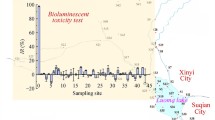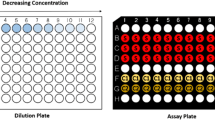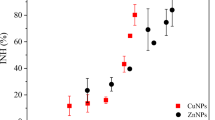Abstract
Variation in zinc toxicity with variation in environmental conditions was studied using the kinetic bioluminescence inhibition assay conducted with live cultures of Aliivibrio fischeri. A good correlation was observed between the static assay and flash assay for colorless non-turbid samples. Color and turbidity had negligible impact on the flash assay results while the static assay caused artifacts. Naturally occurring water samples showed wide variation in the toxicity profiles. Change in zinc toxicity was determined in response to variation in hardness, alkalinity and other coexisting cations/anions in model lake water and in the presence of a solid matrix. The presence of other anions and cations in model lake water reduced and enhanced zinc toxicity, respectively, due to changes in zinc speciation, and bioluminescence inhibition was well correlated with free zinc ion concentration. Increase in alkalinity and sulfate in model lake water lowered zinc toxicity, whereas increase in ammonium ions enhanced the toxicity. Variation in toxicity with hardness was dependent on the Ca: Mg hardness ratio in the samples. The presence of solid matrix decreased toxicity of the aqueous extracts, and toxicity of the matrix was found to increase with decreasing grain size. Speciation pattern of zinc in the respective fractions, however, revealed no direct relationship between zinc associated with fraction that are considered bioavailable to higher organism and the observed toxicity. This assay may be recommended for toxicity analysis of environmental samples since most of the results obtained correlate well with observations reported in toxicity studies with higher organisms.






Similar content being viewed by others
References
Agnihotri S, Bajaj G, Mukherji S, Mukherji S (2015) Arginine-assisted immobilization of silver nanoparticles on ZnO nanorods: an enhanced and reusable antibacterial substrate without human cell cytotoxicity. Nanoscale 7(16):7415–7429
Boluda R, Quintanilla JF, Bonilla JA, Saez E, Gamon M (2002) Application of Microtox test and pollution indices to the study of water toxicity in the Albufera Natural Park (Valencia, Spain). Chemosphere 46:355–369
Brown PL, Markich SJ (2000) Evaluation of the free ion activity model of metal–organism interaction: extension of the conceptual model. Aquat Toxicol 51:177–194
Cardoso PG, Pereira E, Duarte AC, Azeiteiro UM (2014) Temporal characterization of mercury accumulation at different trophic levels and implications for metal biomagnification along a coastal food web. Mar Pollut Bull 87:39–47
Casado MP, Macken A, Byrne HJ (2013) Ecotoxicological assessment of silica and polystyrene nanoparticles assessed by a multitrophic test battery. Environ Int 51:97–105
Dhanakumar S, Solaraj G, Mohanraj R (2015) Heavy metal partitioning in sediments and bioaccumulation in commercial fish species of three major reservoirs of river Cauvery delta region, India. Ecotoxicol Environ Saf 113:145–151
Erickson RJ, Benoit DA, Mattson VR, Nelson HP, Leonard EN (1995) The effects of water chemistry on the toxicity of copper to fathead minnows. Environ Toxicol Chem 15:181–193
Eriksson E, Baun A, Mikkelsen PS, Ledin A (2006) Risk assessment of xenobiotics in stormwater discharged to Harrestrup A, Denmark. Desalination 215:187–197
Garcia GE, Andreu V, Boluda R (1995) Distribution of heavy metals in rice farming soils. Arch Environ Contam Toxicol 29:476–483
Geng J, Wang Y, Luo H (2015) Distribution, sources, and fluxes of heavy metals in the Pearl River Delta, South China. Mar Pollut Bull 101:914–921
Gomez S, Villar C, Bonetto C (1997) Zinc toxicity in the fish Cnesterodon decemmaculatus in the Paranfi River and Rio de La Plata Estuary. Environ Pollut 99:159–165
Heijirick DG, Jansen CR, Karlen C, Wallinder IO, Leygraph C (2002) Bioavailability of zinc in runoff water from roofing materials. Chemosphere 47:1073–1080
Hyne RV, Pablo F, Julli M, Markich SJ (2005) Influence of water chemistry on acute toxicity of copper and zinc to the cladoceran Ceriodaphnia CF dubia. Environ Toxicol Chem 24:1667–1675
ISO 11348-1 (1998) Water quality-determination of the inhibitory effect of water samples on the light emission of Vibrio fischeri (Luminescence bacteria test)-part 1: method using freshly prepared bacteria. International Organization for Standardization, Geneva
Jennings VL, Raynor-Brandes MHH, Bird DJ (2001) Assessing chemical toxicity with the bioluminescent photobacterium (Vibrio fischeri): a comparison of three commercial systems. Water Res 35:3448–3456
Jeswani H, Mukherji S (2014) Comparison of acute toxicity of algal metabolites using bioluminescence inhibition assay. NUJET J 3:25–28
Jeswani H, Mukherji S (2015) Treatment of simulated biomass gasification wastewater of varying strength in a three stage rotating biological contactor. Chem Eng J 259:303–312
Kemka N, Nijine T, Togouet SHZ, Menbohan SF, Nola M (2006) Eutrophication of lakes in urbanized areas: the case of Yaounde municipal lake in Cameroon, Central Africa. Lakes Reserv Res Manag 11:47–55
Kokkali V, van Delft W (2014) Overview of commercially available bioassays for assessing chemical toxicity in aqueous samples. TrAC Trends Anal Chem 61:133–155
Krężel A, Maret W (2016) The biological inorganic chemistry of zinc ions. Arch Biochem Biophys 611:3–19
Lappalainen J, Juvonen R, Nurmi J, Karp M (2001) Automated color correction method for Vibrio fischeri toxicity test: comparison of standard and kinetic assays. Chemosphere 45:635–641
Launay MA, Dittmer U, Steinmetz H (2016) Organic micropollutants discharged by combined sewer overflows: characterisation of pollutant sources and stormwater-related processes. Water Res 104:82–92
Leitgib L, Kálmán J, Gruiz K (2007) Comparison of bioassays by testing whole soil and their water extract from contaminated sites. Chemosphere 66:428–434
Lin JG, Chen SY, Su CR (2003) Assessment of sediment toxicity by metal speciation in different particle sized fractions of river sediments. Water Sci Technol 47:233–241
Ma XY, Wang XC, Ngo HH, Guo W, Wu MN, Wang N (2014) Bioassay based luminescent bacteria: interferences, improvements, and applications. Sci Total Environ 468–469:1–11
Ma Y, Egodawatta P, McGree J, Liu A, Goonetilleke A (2016) Human health risk assessment of heavy metals in urban stormwater. Sci Total Environ 557–558:764–772
Mcgrath SP, Knight B, Killham K, Preston S, Paton GI (1999) Assessment of the toxicity of metals in soils amended with sewage sludge using a chemical speciation technique and a Lux-based biosensor. Environ Toxicol Chem 18:653–659
Mohapatra S, Huang CH, Mukherji S, Padhye LP (2016) Occurrence and fate of pharmaceuticals in WWTPs in India and comparison with a similar study in the United States. Chemosphere 159:526–535
Niyogi S, Blewett TA, Gallagher T, Fehsenfeld S, Wood CM (2016) Effects of salinity on short-term waterborne zinc uptake, accumulation and sub-lethal toxicity in the green shore crab (Carcinus maenas). Aquat Toxicol 178:132–140
Ouellet JD, Dubé MG, Niyogi S (2013) Influence of elevated alkalinity and natural organic matter (NOM) on tissue-specific metal accumulation and reproductive performance in fathead minnows during chronic, multi-trophic exposures to a metal mine effluent. Ecotoxicol Environ Saf 95:104–112
Pandey B, Suthar S, Singh V (2016) Accumulation and health risk of heavy metals in sugarcane irrigated with industrial effluent in some rural areas of Uttarakhand, India. Process Saf Environ Prot 102:655–666
Paquin P, Santore R, Mathew R (2005) The biotic ligand model windows interface, Version 2.2.3. HydroQual Inc, Mahwah
Parvez S, Venkataraman C, Mukherji S (2006) A review on advantages of implementing luminescence inhibition test (Vibrio fischeri) for acute toxicity prediction of chemicals. Environ Int 32:265–268
Parvez S, Venkataraman C, Mukherji S (2008a) Toxicity assessment of organic contaminants: evaluation of mixture effects in model industrial mixtures using 2n full factorial design. Chemosphere 73:1049–1055
Parvez S, Venkataraman C, Mukherji S (2008b) Toxicity assessment of organic pollutants: reliability of bioluminescence inhibition assay and univariate QSAR models using freshly prepared Vibrio fischeri. Toxicol In Vitro 22:1806–1813
Parvez S, Venkataraman C, Mukherji S (2009) Nature and prevalence of non-additive toxic effects in industrially relevant mixtures of organic chemicals. Chemosphere 75:1429–1439
Rai SP, Kumar V, Singh O, Jain SK (2007) Hydrochemical characteristics of Mansar lake, Jammu and Kashmir in India. J Inst Eng India Ser A Environ Eng 88:16–22
Ringwood AH, Delorenzo ME, Ross PE, Holland AF (1997) Interpretation of Microtox solid phase tests: the effects of sediment composition. Environ Toxicol Chem 16:1135–1140
Rubinos DA, Calvo V, Iglesias L, Barral MT (2014) Acute toxicity of arsenic to Aliivibrio fischeri (Microtox® bioassay) as influenced by potential competitive–protective agents. Environ Sci Pollut Res 21:8631–8644
Scheerer S, Gomez F, Lloyd D (2006) Bioluminescence of Vibrio fischeri in continuous culture: optimal conditions for stability and intensity of photoemission. J Microbiol Meth 67:321–329
Tamim U, Khan R, Jolly YN, Fatema K, Das S, Naher K, Islam MA, Islam SMA, Hossain SM (2016) Elemental distribution of metals in urban river sediments near an industrial effluent source. Chemosphere 155:509–518
Wu Q, Zhou H, Tam NFY, Tian Y, Tan Y, Zhou S, Li Q, Chen Y, Leung JYS (2016) Contamination, toxicity and speciation of heavy metals in an industrialized urban river: implications for the dispersal of heavy metals. Mar Pollut Bull 104:153–161
Yim JH, Kim KW, Kim SD (2006) Effect of hardness on acute toxicity of metal mixtures using Daphnia magna: prediction of acid mine drainage toxicity. J Hazard Mater 138:16–21
Zhu Y, Zou X, Feng S, Tang H (2006) The effect of grain size on the Cu, Pb, Ni, Cd speciation and distribution in sediments: a case study of Dong Ping lake, China. Environ Geo 50:753–759
Acknowledgements
The authors acknowledge Prof. Santanu Banerjee, Department of Earth Sciences, IIT Bombay, for facilitating the studies for soil texture analysis.
Author information
Authors and Affiliations
Corresponding author
Additional information
Editorial responsibility: Josef Trögl
Electronic supplementary material
Below is the link to the electronic supplementary material.
Rights and permissions
About this article
Cite this article
Shome, N., Mukherji, S. Application of kinetic bioluminescence inhibition assay using live cultures of Aliivibrio fischeri for determination of zinc toxicity. Int. J. Environ. Sci. Technol. 15, 1313–1322 (2018). https://doi.org/10.1007/s13762-017-1479-8
Received:
Revised:
Accepted:
Published:
Issue Date:
DOI: https://doi.org/10.1007/s13762-017-1479-8




